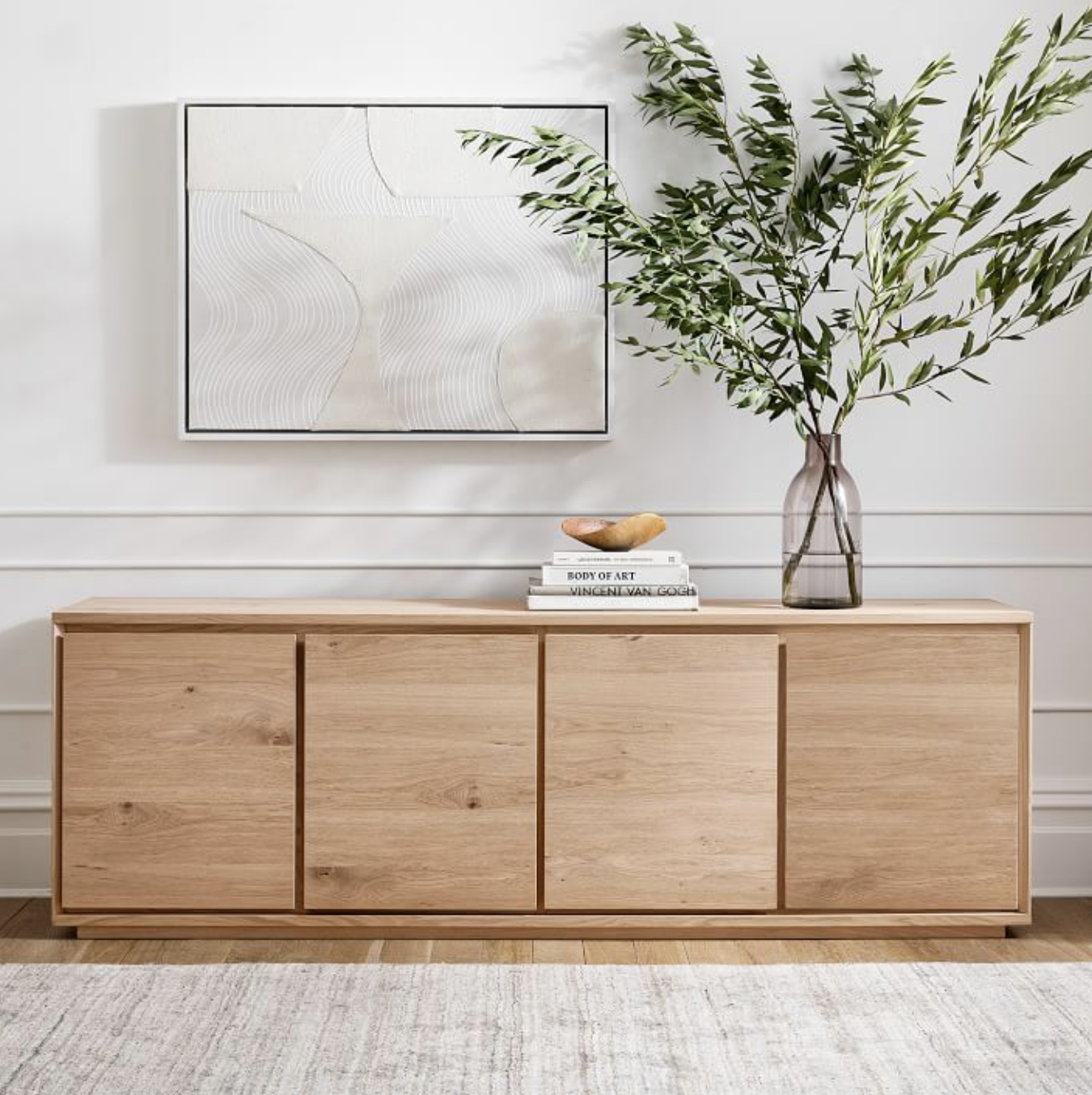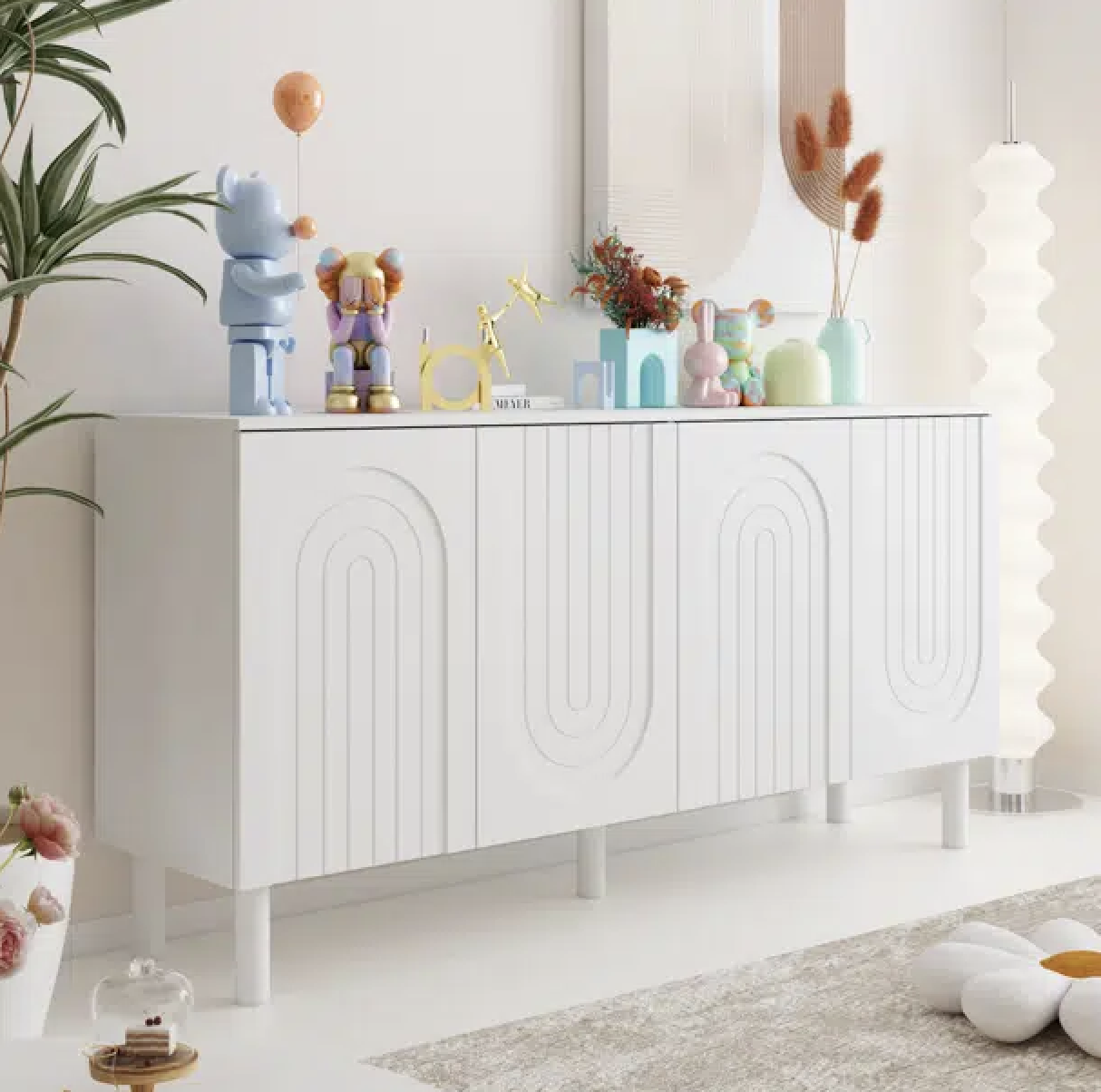By Christina DesAuguste
Christina is the founder of The Organizing Company and has been organizing professionally since 2013. You can find her at the park with her dog and husband any given Saturday afternoon.
Affiliate Disclosure: Some of the links on our website are affiliate links, meaning, at no additional cost to you, we will earn a commission if you click through and make a purchase.
I know everyone wants to maximize their space, but for some of us, the struggle is really real.
My husband and I (and our mutt, Aspen) just downsized to 731 square feet. It was time to simplify and a great way to save for the dream home. So we took the plunge and got real cozy. Let me share some practical guidelines for organizing small spaces, plus a few little tips, that I’ve been personally reminded of lately.
As always, make sure that you’re using these tips and principles in conjunction with my full organizing method.
Tips alone don’t help if you aren’t already moderately organized and know the basics of how to organize. If that hits like, “Ooh. Can she see me right now?”-first watch my 9 minute video, START HERE: Learn To Organize Anything In Less Than 10 Minutes. It’s free, friends!
You’ll also get a BONUS Method Cheatsheet so you can easily refer back to each step as you organize. Print it out or save it to your photos.
Small Space Organizing Principle #1 is an oldie but a goodie. Maximize your vertical space.
You may only have 700 square feet of floor space, but if your ceilings are 10 feet high, you’ve got lots of cubic feet to work with. Focus on how you can utilize storage with a small footprint, but lots of height. A tall bookcase or cabinet instead of a low and wide one. Hang your clothes drying rack up high instead of leaving it on the floor. Make sure you maximize your kitchen cabinets by adding more shelves or using shelf risers (some people call them cabinet shelves). This keeps your dishes easier to access (coffee mugs stacked 3 high like a Jenga tower is no way to wake up) while also making it so you can use more vertical space instead of more cabinet space. I use shelf risers in the pantry, for bakeware and spices, for cocktail glasses and mugs, for Tupperware, for tea, and probably a few other things I’m forgetting. They’re an inexpensive and really versatile way to add more storage while keeping it functional.
Check out these options:
The Container Store carries luxe (and discreet!) options like this acrylic shelf riser, as well as ones for all the big stuff (think water bottles, cleaning supplies, etc. Shelf risers aren’t limited to kitchens!
My top picks from Amazon include a simple, modern solution and an expandable and adjustable height option.
West Elm has great options for a more polished, less utilitarian look.
Here’s a bonus link for you too: West Elm also carries a stove stop shelf riser to help keep your go-to oils and salt & pepper off the counter. Another great way to utilize vertical space.
A few reminders before you start putting your toothbrush or kettlebells on the highest shelves:
Put the things you use least in the hardest to reach places. For most people that’s up high, but I also have a lot of clients who hate to bend down and dig something out of a lower cabinet and would rather grab a step stool. So decide what is easiest to access for you personally, and put your most used items there.
Make sure you have a stool handy. There are some really great thin options out there to save space. This one will give you an extra 46” of reach but is only 1.8” wide when folded. If you don’t have a stool (or for less small spaces, stools) easily within reach, you’ll get frustrated real fast. Not that I know from personal experience or anything…
Set yourself up for success by making the things up high easy to access. If they are too difficult to get down or get into, you will either never use them (ugh, wasted space) or, more likely, you’ll get something out and never put it back. So maybe it’s a closet size shelf riser (or adding in extra wall mounted closet shelves) so you don’t have to move three boxes to get to the one you want. Or using drop front boxes that you can just reach into instead of having to move.
Also make sure whatever you put up high is a manageable weight. And bins have lids so things don’t spill out as you take them down at an angle. Again, not that I’ve had that happen to me, but… save yourselves.
Don’t put things on top of your kitchen cabinets. A lot of places have empty space above the cabinets before you hit the ceiling. I see it utilized often and, honestly, putting things up there will make your space feel smaller, more cluttery, more dated, and more dusty. The amount of dust- and grease!- I find in up there in clients’ homes is unreal. Just say no. And if you’re designing a small space, opt for closed cabinetry all the way to the ceiling. You don’t have to use it all, but at least make it usable.
One last thought about going vertical: sometimes if you have to get too ingenious to fit everything in, that’s an indicator that you may have too much for your space. You could put in a motorized overhead rack in your living room for more storage, but there is a point when “maximized” becomes “stuffed” and gives that walls-closing-in-on-you (or your guests) feeling. And it actually is less functional/comfortable, less attractive, and certainly more cluttery feeling. Find the sweet spot, my friends.
Small Space Tip #2 is all about balance.
From an organizing perspective, using furniture with storage is a great way to contain things when you don’t have large closets or storage areas.
From a design perspective, in a small space you want low profile, light and airy furniture. Maybe a glass coffee table, or one with thin legs, for example. Open, airy shelves.
So you’ve got to find that balance between what makes the space look bigger and what provides storage. What both designers and organizers agree on is that clutter everywhere will definitely not make the space feel bigger.
I believe there’s always a solution. Design and organization aren’t mutually exclusive. You don’t have to use a giant clunky 90’s entertainment center just because it provides storage. And you don’t have to use a ladder bookshelf instead of a traditional one (or a cabinet with doors), even if it does feel lighter.
To help you find the balance, also consider scale and color. An oversized, dark wood coffee table (storage or not!) may make the space feel dominated. Instead opt for a more petite version in a lighter tone that has some drawers or a lift top to contain the clutter. Just don’t choose one that only has two glass shelves, please.
Also, remember that open or glass front shelving (whether fixed or freestanding) can make a small space look cluttery.
These pieces are nice, but busy.
Too many knick knacks, too many dishes, exposed utilitarian items like toiletries and coffee accessories. It gets busy quickly. This goes for open shelves in the kitchen, the bathroom, and anywhere you might have bookshelves or display shelves. Unless you are VERY diligent about minimizing your belongings and can make open shelving look artful and clean while still keeping the rest of your space functional, you’re either going to end up with overfilled open shelves that don’t look good, or overfilled closed shelves/cabinets/closets because the open shelves are wasted decorative space that you desperately need for functional storage. Only you (or me, if you want to bring in the big guns) know which it would be.
But I can speak from my own experience and from my professional experience, cluttery/busy is just what tends to happen with open/glass door shelving in most homes, but especially in small spaces.
Give the eye a little less to look at and you’ll like what you see a lot more.
Other types of closed storage furniture (and fixtures):
Bedside table with drawers instead of shelves.
A shoe cabinet instead of a shoe rack. This and this are two of my favorites.
Tall cabinets like this one. You can easily elevate it with some new hardware. I’ve used something like this for myself for linens, office supplies, and even as a pantry.
A closed drop zone or playroom cabinet instead of a cubby system. No offense to those of you partial to the cubby (aka cube shelf), but I have a few beefs with these: 1. The fabric bins don’t last and plastic ones are hard to find. And get heavy. 2. Too many bins looks boring or busy. Or both. 3. Somehow the bins disappear (maybe reason #1) and then the cubby is just crammed with stuff and looks messy. 4. The size isn’t useful for very many categories. They’re either way too big and then you have one bin with many categories jumbled together (that makes my skin crawl!), or they’re too small for things like shoes and you’re constantly digging and cramming. I don’t like either of those words for you. Using a cabinet allows you to add bins that are the right sizes to fit your stuff and are stackable (or drawers that are easy to pull out) so you can keep more categories contained but separated from the other things around them. Ahh, good ol’ fashioned organization.
A media cabinet instead of a media stand. This one is nice.
You can also utilize things like a mirror with storage for jewelry, or build in a medicine cabinet (or hang an external one) to hide your toiletries. There are a lot of modern medicine cabinets that hang above a sink, instead of those small old school side wall ones. They provide a ton of functional storage and aren’t an eye sore.
Small Space Tip #3: Don’t buy in bulk.
This is also a major thing I talk about with clients even when they don’t live in a small space. Really look at this in your own life. In mine we’ve cut back our Costco purchases to only a few items that are really worth it and that we go through quickly: Kerry Gold Butter (I didn’t know there were butter snobs until my husband discovered Kerry Gold), Yuzu Pineapple Liquid I.V. (my lifeline), eggs, and meat for our dog’s homemade food we make in big batches (she, and her sensitive stomach, are anti-kibble). No more facial tissue. No more freezer foods. No more cleaning products. We just don’t have the room to store so much at once.
Sometimes we have to sacrifice saving a few bucks to save our sanity. When the pantry and closets are overflowing, it creates stress and chaos and keeps you from enjoying your home. Plus, it often hinders your earning potential and costs you more in organizing supplies and services (not that I’m trying to talk myself out of a job). But I digress…
You’re already saving money by living in a smaller space, which, in my case, far outweighs the savings of buying in bulk over the course of a year. Instead, take advantage of click and pick up grocery services (King Soopers is ready for you Colorado folks!) or Target free pickup, or use Amazon Prime free two day shipping instead of having back stock in your house. Let Amazon store it! They have the space, you don’t right now.
Small Space Tip #4: Curate.
Never is it more true that you need to pick the best of the best than when you are in a tight space. Whether you’re moving, just reorganizing your current place, or thinking about buying something new for your space- Curate it.
My organizing method has a step called “Curate It”. Whatever “it” is, go through it: your clothes, your dishes, your DVDs, and all those random cords.
You don’t want to focus just on what you love, or over-emphasize getting rid of things. Purging everything and starting from scratch won’t solve your problems.
Why do I call it curating? When a museum curates an exhibit they can’t display every Monet, for example. They pick a theme, like Water Lilies, or a time period, or a sampling to give the broadest overview. Or sometimes just the most popular works.
It’s the same when we look at our stuff.
We can’t always keep everything we love, so choose the best and the most useful.
Consider what a complete set or collection is and let the rest go.
It’s easiest to think about this with your wardrobe. Consider the activities you do most and what you need to wear for them. The activities you don’t do often (formal events, maybe business casual for a lot of you, cycling for those of you not in Boulder, etc) shouldn’t be a large part of your wardrobe. Maybe you keep 1-3 suits (your favorites/best/most useful) instead of 10. Your wardrobe should be broken down proportionally to how you spend your time/how you dress. Maybe that’s something like 70% what you wear 9:00-5:00, 15% date night/weekend outfits, 10% activewear, 5% formal/infrequent items. That’s true for your undergarments as well. If you don’t go to formal occasions often, you probably don’t need 5 strapless/backless options and 10 varieties of Spanx.
So thinking about the proportion of the categories of your clothes/shoes/etc helps you make sure you have what you need. You’ve planned for your hobbies, for work, for your social life. You have a complete wardrobe. And what you’ll find is you don’t feel like you have to hang onto a bunch of other options for those things.
When you start with this “collection” or curating idea and choose items based on that first, you can look at what’s left and feel the freedom to let go, or make better decisions, because you know you’re covered.
If you try to just pick what you love, or just force yourself to start getting rid of things, I guarantee you’ll either keep way too much (this is true for both approaches, actually!) or you’ll have regret about getting rid of things. You have to look at the big picture and not just focus on the extremes.
So apply that concept to the kitchen and every other area in your home, and see where you can refine. Where you can get down to just the best/most useful items. If you haven’t checked out my free guide yet, check it out for more on this and what to do once you’ve finished curating.
I’ve found over and over in my own life, and especially during this most recent move, that a little bit here and there makes a big difference everywhere.
Getting rid of 2 mugs, 4 Tupperwares, 1 gadget, 1 appliance, and 5 cocktail/beer glasses doesn’t sound like a lot. But it adds up and makes every area a little more manageable. I also find that I can often condense categories after I curate again, which means that I open up space for something else that needs it more. All and all, making things more breathable, more beautiful, and more functional.
That’s what I hope for you in your small space.
Let me know how it goes for you! I’ll share more about my small space journey soon!
Happy Organizing!
Christina
P.S. One quick bonus tip not necessarily about organizing, but you may appreciate: Minimize your decor. Put less stuff on your walls. Opt for a couple medium size pieces instead of a busy gallery wall. Don’t put something on every wall. Do fewer vases/frames/decorative items on shelves and counters and allow more empty space in your decor. Maybe apply Coco Chanel’s rule for accessorizing your outfit and, when you think you’re done decorating, look around and remove one item. Or three. :)
November 9, 2023
Share & Follow


























